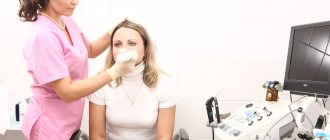Author:
- Ivanova Yulia Sergeevna
otorhinolaryngologist
4.40 (Votes: 5)
How often do we resort to self-medication without thinking, especially if we have to treat a common runny nose. What would seem simpler: in any pharmacy there is a wide variety of vasoconstrictor drops , which, after instillation into the nose, cause vasoconstriction and, as a result, relieve swelling and reduce mucus formation. And here it is, the longed-for freedom of nasal breathing for several hours.
Few people think that vasoconstrictor drops do not have a therapeutic effect, but only relieve symptoms for a short time. After the medication wears off, the swelling reappears, so it makes no sense to treat a runny nose of any origin only with vasoconstrictor drops. This is only an auxiliary therapy that helps ease nasal breathing during the treatment period.
What is naphthyzin and why is it dangerous?
Naphthyzin are short-acting vasoconstrictor drops that easily penetrate both the wall of the vessels of the nasal cavity and the general bloodstream, exerting a vasoconstrictor effect on all vessels in general, and therefore is contraindicated in cases of severe hypertension.
Now on the pharmaceutical market there are many vasoconstrictor drops that differ in composition: there are both short- and long-acting drugs, but unfortunately, all of them can cause symptoms of naphthyzine poisoning .
Even less do we think about the fact that drops can be life-threatening, especially when used in children. An overdose of drops, exceeding the dose of the drug by 3-4 times, can cause such a serious complication as naphthyzine poisoning. As a rule, this happens when the age-specific concentration of the solution is not observed, or when the visual number of drops that have entered the nose is difficult, or simply when they are used uncontrolled, when the child does it himself or the drops are within his reach.
Naphthyzin
Dosage form
Nasal drops
Composition per 1 ml
Active substance:
naphazoline nitrate – 0.5 mg or – 1 mg.
Excipients:
boric acid – 20 mg, purified water – up to 1 ml.
Description
Transparent, colorless or almost colorless liquid with a yellowish tint.
Pharmacotherapeutic group
Anticongestant - vasoconstrictor (alpha-adrenergic agonist).
ATX code:
R01AA08.
Pharmacological properties
Pharmacodynamics
Naphthyzin has a rapid, pronounced and long-lasting vasoconstrictor effect on the vessels of the nasal mucosa (reduces swelling, hyperemia, exudation). Facilitates nasal breathing during rhinitis. After 5-7 days, tolerance occurs.
Pharmacokinetics
When applied topically, systemic absorption is low. The vasoconstrictor effect occurs within a few minutes and continues for several hours.
Indications for use
Acute rhinitis, allergic rhinitis, sinusitis, eustachitis, laryngitis, laryngeal edema of allergic origin, laryngeal edema due to irradiation, hyperemia of the mucous membrane after operations on the upper respiratory tract, to facilitate rhinoscopy, to stop nosebleeds, to prolong the effect of local anesthetics used for superficial anesthesia.
Contraindications
Hypersensitivity to the components of the drug, arterial hypertension, severe atherosclerosis, thyrotoxicosis, chronic rhinitis, atrophic rhinitis, severe eye diseases, closed-angle glaucoma, diabetes mellitus, tachycardia, simultaneous use of monoamine oxidase inhibitors (MAOIs) and a period of up to 14 days after the end of their use, children age up to 1 year (for 0.05% solution), children up to 18 years of age (for 0.1% solution).
Carefully
Coronary heart disease (angina pectoris); prostatic hyperplasia; pheochromocytoma, pregnancy, breastfeeding period, porphyria; use of other drugs that increase blood pressure.
Use during pregnancy and breastfeeding
Use for the treatment of pregnant women and during breastfeeding is possible only if the expected benefit to the mother outweighs the potential risk to the fetus or child. You should consult your doctor.
Directions for use and doses
Place in each nasal passage. Adults are prescribed 1-3 drops of 0.05% or 0.1% solution 3-4 times a day. For children, a 0.05% solution is used: from 1 to 6 years – 1-2 drops, from 6 to 18 years – 2 drops 1-3 times a day.
For diagnostic purposes - after cleaning the nasal cavity, 3-4 drops are instilled into each nasal passage or a tampon soaked in a 0.05% solution is inserted and left for 1-2 minutes; in case of swelling of the vocal cords, administer 1-2 ml of a 0.05% solution of the drug in small doses with a laryngeal syringe; in case of bleeding, insert a tampon moistened with a 0.05% solution of the drug.
For rhinitis, the course of treatment should not exceed 5-7 days in adults and no more than 3 days in children.
As an additional drug for surface anesthesia - 2-4 drops per 1 ml of local anesthetic.
May have a resorptive effect. With long-term use, the severity of the vasoconstrictor effect gradually decreases (the phenomenon of tachyphylaxis), and therefore it is recommended to take a break for several days after 5-7 days of use.
Side effect
Nausea, tachycardia, headache, increased blood pressure, reactive hyperemia, swelling of the nasal mucosa, irritation of the nasal mucosa. Local reactions, when used for more than 1 week - swelling of the nasal mucosa, atrophic rhinitis.
Overdose
Symptoms: decreased body temperature, bradycardia, increased blood pressure.
Treatment: symptomatic.
Interaction with other drugs
Concomitant use with MAO inhibitors or within 14 days after the end of their use is contraindicated.
Slows down the absorption of local anesthetic drugs (prolongs their effect during superficial anesthesia).
Co-administration of other vasoconstrictor drugs increases the risk of side effects.
special instructions
May have a resorptive effect.
With long-term use, the severity of the vasoconstrictor effect gradually decreases (the phenomenon of tachyphylaxis), and therefore it is recommended to take a break for several days after 5-7 days of use.
Long-term use and overdose of the drug should be avoided, especially in children.
The effect of the drug on the ability to drive vehicles and machinery
Not found.
Release form
Nasal drops 0.05%, 0.1%.
5, 10, 15, 20, 25 ml of the drug in dark glass bottles sealed with polyethylene stoppers and screw-on plastic caps or sealed with polyethylene closures, or caps or lids with a dosing pipette, or a dispenser nozzle or a plastic dropper and a lid or cap included , or a dropper or dispenser or dosing pipette with a lid or cap, or dropper caps or screw-on caps with a hole and a dropper included, or dropper caps.
5, 10, 15, 20, 25 ml of the drug in polyethylene bottles, polyethylene dropper bottles, polyethylene jars or polyethylene dropper bottles complete, sealed with polyethylene stoppers and screw-on plastic caps, or sealed with polyethylene closures, or caps or lids with a dosing pipette , or a dispenser or plastic dropper and a lid or cap included, or a dropper or dispenser or dosing pipette with a lid or cap, or dropper caps or screw-on lids with a hole and a dropper included, or dropper caps.
5, 10, 15, 20, 25 ml in polyethylene terephthalate bottles, sealed with polyethylene terephthalate screw caps.
2 ml in a dropper tube with a valve or 10 ml, 15 ml, 20 ml in a dropper tube with a screw neck, made using the “blow-fill-seal” technology from high-density polyethylene.
A label made of writing or label paper or a self-adhesive label is glued to each bottle, dropper bottle, jar, dropper tube.
Each bottle, dropper bottle, jar, dropper tube, together with instructions for use, is placed in a pack of boxed cardboard for consumer packaging or chrome-ersatz cardboard.
It is allowed to pack bottles, dropper bottles, jars, dropper tubes without a pack from 9 to 200 pieces with an equal number of instructions for use in a corrugated cardboard box (for hospitals).
Storage conditions
In a place protected from light at a temperature not exceeding 25 ° C.
Keep out of the reach of children.
Best before date
3 years. After opening the package, use within 30 days.
Do not use after the expiration date stated on the packaging.
Vacation conditions
Over the counter.
Signs of mild or initial stages of naphthyzine poisoning:
- increased arousal
- cardiopalmus
- dizziness
- abdominal pain
If the drug continues to accumulate in the body or the overdose was more significant, then the symptoms worsen: the heart rate slows down significantly, blood pressure drops, and severe lethargy, weakness, and drowsiness appear. At the same time, the child is sleeping, but this sleep is unnaturally deep, the tone in the arms and legs drops (if you lift them, they fall like “lashes”), confusion, a decrease in body temperature, the skin becomes pale, cold and damp, breathing is shallow.
Side effects
In isolated cases, taking the drug does not occur without side effects. After instillation of the medicine into the conjunctival cavity, it causes a slight tingling sensation. The burning goes away within a few minutes.
The mechanism of action of the drug can significantly reduce the patient’s quality of life. The drug affects the central nervous system, in rare cases leading to episodes of pain in the head and neck.
The drug increases systolic blood pressure, leading to mild, moderate, severe, isolated or borderline hypertension. Also leads to increased heart rate. The medicine should be taken with caution in old age, especially if there are fluctuations in blood pressure and its regular increase.
In addition, an increase in blood pressure leads to an increase in intraocular pressure. With prolonged use, you can develop a new problem called glaucoma. This fact has not been scientifically proven, but it is not excluded either.
Less commonly, Naphthyzin, when applied topically to the eyes, leads to nausea and vomiting, redness of the conjunctiva and eyelids, and swelling of the mucous membrane.
In case of an overdose of the drug, the following symptoms appear:
- drowsiness;
- insomnia;
- nervousness and overexcitement;
- dry mucous membranes;
- sand in the eyes;
- pain;
- increased sensitivity to bright light.
Long-term use not only causes an overdose, Naphthyzin leads to a deterioration in the nutrition of the eye structures, and accordingly can cause more severe conditions.
What to do if these symptoms appear while using vasoconstrictor drops?
First of all, call an ambulance. Before the doctor arrives: stop taking the drug, cover the patient with a blanket, give him a warm drink, measure the temperature, blood pressure and try to maintain consciousness, do not let him fall asleep. Considering the seriousness of the consequences, do not use vasoconstrictor drops, especially if the child is sick; be sure to consult an otolaryngologist to prescribe treatment and follow-up over time. Remember that most vasoconstrictor drops can be used for 2-3 to 5-7 days; this is a short period of time that must be used to treat the inflammation process.
In ENT clinic number 1, in order to minimize the number of prescriptions of drug therapy, they will help you relieve swelling and inflammation using unique highly effective physiotherapeutic techniques, such as: USOL therapy of the nasopharynx, photochromotherapy of the nose, laser therapy of the nose, which will allow in the shortest possible time not only to relieve swelling, but and the cause of inflammation.
Can you put it in your eyes or not?
The effect of the drops is immediate. Alcoholics and drug addicts use the medicine more often, since red proteins attract attention, and Naphthyzin quickly eliminates this symptom by narrowing the blood vessels in the eyes.
There are two types of nasal drops with a concentration of 0.1% and 0.05%. The former is not recommended for the treatment of eye diseases or masking reddened whites; it causes rapid addiction, as well as a feeling of dry mucous membranes and stinging in the eyes.
You can use 0.1% medication only as prescribed by your doctor. It is better to buy special medications designed to treat ophthalmological diseases. 0.5% remedy is prescribed for conjunctivitis of microbial origin and chronic. Drops of 0.05% are considered children's. They can be used in the treatment of eye diseases. The official instructions for the medication indicate that the use of Naphthyzin in this concentration is permitted for allergic conjunctivitis.
It should be understood that both forms of the solution increase blood pressure, including affecting intraocular pressure. If a patient’s blood pressure constantly fluctuates and he has been suffering from high blood pressure for a long time, then illiterate use of the drug will lead to serious consequences.
Due to serious side effects and complications after use, only an ophthalmologist has the right to select the drug and prescribe it. You cannot buy it yourself, much less determine the dosage.
Mode of application
The medicine can be used within 28 days after the bottle is depressurized.
To alleviate the patient's condition, Naphthyzin is prescribed in combination with other medications. The medicine is prescribed not according to the instructions, but depending on the patient’s condition and the severity of conjunctivitis.
It is recommended to use the medication 2–3 times a day, 1 drop. To do this, wash your hands with soap and unscrew the cap. Pull back the lower eyelid and drip the drug into the conjunctival cavity, carefully pressing on the bottle so as not to squeeze out a lot of the solution.
When is the use of Naphthyzin in the eyes justified?
The use of a medicinal solution in the eyes is justified only for chronic and allergic conjunctivitis. For other pathologies of the optical system, the use of Naphthyzin is strictly contraindicated.
Since the nasal solution constricts the blood vessels in the eyes, thereby eliminating swelling and increased lacrimation, hyperemia, discomfort and burning, it is prescribed for the allergic form of conjunctivitis.
This effect of the drug is difficult to underestimate. After all, Naphthyzin quickly solves the problems of red eyes and irritation, restoring shine and whiteness. It quickly makes you feel better in any form of allergic conjunctivitis (seasonal, domestic or year-round).
It is recommended to use only the drug for children, since adults have a higher concentration and, accordingly, will lead to the development of glaucoma faster.
In addition, the price of Naphthyzin is significantly lower than that of ophthalmic drugs for these conditions.
Contraindications
The drug has many contraindications in ophthalmology. It is not recommended for use in cases of increased pressure inside the eye and glaucoma. In the latter case, the use of the medication is permitted on the recommendation of an ophthalmologist.
Naphthyzine should not be used in the following conditions:
- keratoconus;
- keratitis;
- hyperfunction of the thyroid gland;
- corneal dystrophy;
- infectious pathologies;
- bacterial ulcer;
- bullous keratopathy;
- corneal erosions;
- insulin-dependent/non-insulin-dependent diabetes;
- disturbances in the functioning of the cardiovascular system;
- hypersensitivity to the components of the drug.
The use of the medicinal composition is contraindicated for more than 4 days. You cannot combine Naphthyzin with MAO inhibitors. The use of the drug is prescribed 2 weeks after discontinuation. The list of contraindications also includes age under 1 year, pregnant and lactating women.
Adequate clinical studies on the effects of the medicinal solution on the fetus and infants have not been conducted.
special instructions
With prolonged use, the medicine stops working. The active ingredient Naphthyzin is addictive. The medication stops working properly.
The vasoconstriction slows down, and the effect of the drug does not occur as quickly as at the beginning of therapy. Addiction leads to pain in the head, sleep disturbances (insomnia), an increase or decrease in heart rate and cyanosis of the skin.
In this case, you should temporarily stop taking the medicine and replace it with an analogue with a different active component.
The medication cannot be used with contact lenses. Nasal drops disrupt their transparency. Before instillation, the optics are removed and can be put on after 15–30 minutes.








